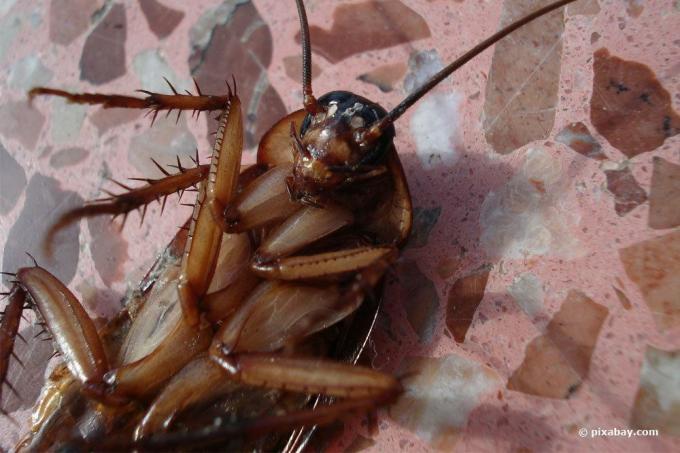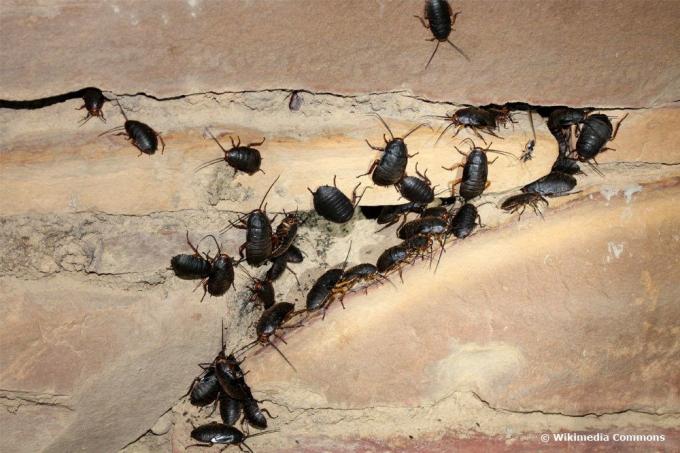
table of contents
- Cultural follower of man
- Good breathing artists
- Caution, flight alarm
- Fast runabouts
- Are bites harmful to your health?
- Vectors of disease
Some just find them gross. Others, on the other hand, are directly afraid of cockroaches because the small crawfish might bite or sting. They are therefore not welcome guests in their own four walls. Everything is done to get rid of them quickly. But do they really pose a health risk for humans?
Cultural follower of man
Cockroaches also called Common cockroaches (Blatta orientalis) known, seek to be close to people. Precisely here are extremely ideal conditions for a carefree life. In addition to temperatures usually above the 20 degree limit, you will also find kitchen waste and other food residues and, above all, moisture. Simply a paradise for cockroaches. Cockroaches are usually associated with dirt, dirt or uncleanliness, but they also feel comfortable in a clean environment.
Good breathing artists
The cockroaches are directly looking for moisture and therefore also warmth. These are most likely to be found in basements, bathrooms and kitchens. They often get to these places through defective pipelines and sewage systems.
Cockroaches are able to hold their breath for at least 40 minutes and survive underwater for 30 minutes. They use this ability to swim through the sewers to their new quarters. This allows them to cover longer distances under water without even having to breathe. Very often the insects find their way into apartments through the toilet. Swimming is therefore not a problem for the animals.
Note: The cockroach can survive headless for at least a week. They do not breathe like normal living beings, but through small holes (stigmata) in the body. Oxygen is absorbed through this. Water is also transported to the outside through these openings; the breathing tubes are simply closed for this purpose.

Caution, flight alarm
Sometimes it is also assumed that the 13 to 16 mm large light to dark brown colored cockroaches fly can, as there are a pair of small wings on their front section of the chest area (prothorax) is located. Usually, however, these are only fully developed in the females. In the males they are rather stunted.
In this way, female animals can save their offspring when they are in danger by simply flying away. The animals carry the eggs under their shell until they hatch. With the males, however, the flight attempts look a bit clumsy. Due to their body proportions, light males are able to glide briefly. However, it looks very clumsy and swaying through the air.
However, they have made a virtue out of it and use the wings to help
- To slow down falls from heights
- to cover shorter distances
- to make higher jumps
Just as they jump, they begin to flap their wings. It then usually looks as if the animals are flying.
Note: In warmer areas it can be observed that the heat favors the development of the wings. There the cockroaches are often flying.
It should be mentioned that not all cockroach species are "unfit to fly", so the American and Australian cockroaches can take to the skies on warm days. In our latitudes, the amber cockroach is one of the flightable specimens. However, it lives exclusively in the forest. The German cockroach tends to cover its routes running and jumping.
Fast runabouts
However, these small animals have to be admitted that they can walk extremely well and, above all, very quickly by their means. In this way, they can cover about 1.5 meters in a second. They take advantage of this fact especially when fleeing from enemies.

In comparison, at the speed of these little runabouts, a person would have to cover at least 250 kilometers on foot in an hour. This makes the cockroach one of the fastest insects in this country.
Are bites harmful to your health?
Cockroaches are usually nocturnal. They are shy of light, so they hide in their hiding places during the day and only come out when it gets dark. If cockroaches are sighted during the day, the cockroach infestation is extremely invasive. As a rule, cockroaches are considered food pests, but they are also omnivores at the same time. Mainly they feed on organic substances like
- Fruit Vegetable
- Meat from dead animals
- Feces
- human dander and hair
- Paper, glue or
- leather
In a pinch, when food is scarce, also from their own conspecifics. In view of the fact that they also bite through and eat leather, they have appropriate mouthparts that can also penetrate human skin. So, in principle, they could bite or stab people. But it is not known that a cockroach would actively bite a human. As a rule, she would be more likely to flee in order to ultimately avoid injuries or to escape death.
However, should a cockroach bite, it will certainly only be during the night and in search of food and water. Such a wound is recognizable
- Swelling around the bite
- delayed, severe pain
The wound must of course be thoroughly disinfected to prevent infection. If so, a doctor should be consulted.

Vectors of disease
Even if cockroaches rarely bite, the presence of these animals in the vicinity of people and also pets poses a particular health risk. In this way, they can transmit diseases, the course of which is associated with more or less serious damage to health for humans and animals, such as
- Hebatitis A
- anthrax
- Salmonella
- tuberculosis
- Colon callosity and
- less often leprosy
The transfer usually takes place through
- the outer skin of the animals
- contaminated food
- Animal excretions
- Moults
Germs can stick to the outer skin of the cockroaches for up to 72 hours. Even if there is no direct contact with the animals, the risk of infection is high. Children, the elderly and people who are already sick are particularly at risk.
Note: Cockroaches can also transmit diseases in agriculture. They particularly like to nestle in the warm and humid animal stalls and can transmit the foot-and-mouth disease.
